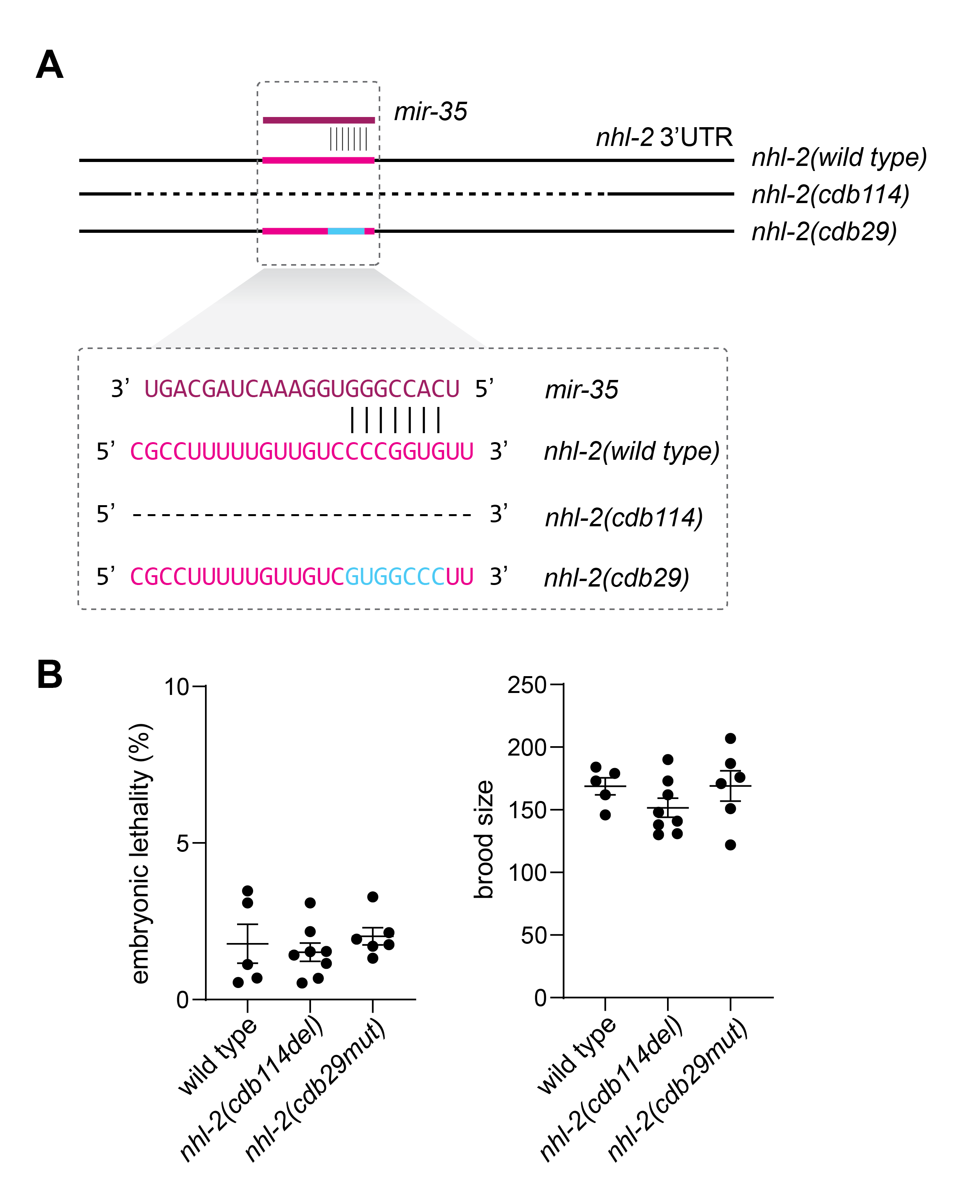Description
The mir-35-42 family of microRNAs (miRNAs) acts redundantly to ensure embryonic viability in C. elegans (Alvarez-Saavedra and Horvitz 2010). We are interested in defining the essential targets that must be repressed by the mir-35-42 family. Our previous work suggested that NHL (ring finger b-box coiled coil) domain containing 2 (nhl-2) may be one such target because genome editing attempts to delete the mir-35-42 seed binding region in the nhl-2 3’UTR were unsuccessful (McJunkin and Ambros 2017). The same CRISPR reagents were successful at creating such a deletion in a background containing an NHL-2 CDS deletion (nhl-2(ok818)) (McJunkin and Ambros 2017). Together, we took these results to mean that derepression of nhl-2 induced lethality or sterility, preventing our isolation of the deletion lines in the wild type context. More recently, CRISPR genome editing reagents and protocols have become many-fold more efficient, most notably by injection of recombinant Cas9 RNPs pre-loaded with synthetic guide RNAs (gRNAs) (Paix et al. 2014). Using injection of Cas9/gRNA RNPs, we have succeeded in deleting and mutating the mir-35-42 seed binding region in the nhl-2 3’UTR in a wild type background (see alleles in Figure 1A). Because such alleles were previously difficult to generate, we quantified their fecundity and embryonic viability (which are two aspects of physiology affected by mir-35 family mutations) (Alvarez-Saavedra and Horvitz 2010; McJunkin and Ambros 2014) to see if they were impaired, but we found these animals to be wild type (Figure 1B). Therefore, our original interpretation – that the difference in CRISPR editing between wild type and nhl-2(ok818) backgrounds was due to negative selection of miRNA binding site mutations in the wild type background – was incorrect. One possible explanation for the observed difference in editing may be alterations in chromatin structure induced by the 1.5kb nhl-2(ok818) deletion. Indeed, nucleosome position and dynamics have been shown to alter efficiency of Cas9 cleavage (Chen et al. 2016; Horlbeck et al. 2016; Isaac et al. 2016; Hinz et al. 2016; Daer et al. 2017; Yarrington et al. 2018; Kim and Kim 2018). Thus, differences in genome editing efficiencies between genetic backgrounds should be interpreted with caution.
Methods
Request a detailed protocolN2 adult hermaphrodites were injected with Cas9/gRNA RNPs to perform CRISPR. For nhl-2(cdb29), the injection mix contained 6μM homemade Cas9, 1.4μM each of three gRNAs (gKM1, gKM20, and gKM3), 27ng/μl of dpy-10 ssDNA oligo repair donor, and 164ng/μl of nhl-2 ssDNA oligo repair donor (gKM102) (Paix et al. 2014; Arribere et al. 2014). The injection mix for cdb114 contained 2μM IDT Cas9, 1μM of gKM26, and 1μM of gKM3. F1 animals with Dpy or Rol phenotype indicating co-CRISPR at dpy-10 were isolated and genotyped by PCR. Genotyping primers are oKM85 and oKM86, which yield a 331-bp fragment in wild type or cdb29 and 256-bp fragment in cdb114. Wild type and cdb29 fragments are distinguished by digestion with NciI, which cuts the wild type PCR product into two fragments (87-bp and 224-bp). All guides were AltR crRNAs from IDT preannealed with IDT tracrRNA, except for gKM20 which was a Synthego sgRNA. Strains were homozygosed and segregated away from dpy-10 mutations (not further backcrossed) and scored for fecundity and viability at 25°C.
The protospacer sequences used:
gKM1 ATCCGCCTTTTTGTTGTCCC
gKM3 GCTACCATAGGCACCACGAG – dpy-10 protospacer from (Arribere et al. 2014)
gKM20 AAAATAATGGAACAACACCG
gKM26 GATGACGGAACGGTGTCACC
Oligonucleotide sequences:
oKM85 GGTCACATTGTGACGTTGTGTAAG
oKM86 GTGGCAAATGAGGTCTCAAAACG
oKM102
CCGTCTTCTTTTTTTTCCTTCTCCCTTTGCTTATCCGCCTTTTTGTTGTCGTGGCCCTTGTTCCATTATTTTAAGTTCCTAAGTTTCTTTCCCCTCCCCA
dpy-10 repair donor
CACTTGAACTTCAATACGGCAAGATGAGAATGACTGGAAACCGTACCGCATGCGGTGCCTATGGTAGCGGAGCTTCACATGGCTTCAGACCAACAGCCTAT
Reagents
MCJ71 nhl-2(cdb29) III
MCJ236 nhl-2(cdb114) III
[The cdb114 breakpoints are as follows: TCCTTCTCCCTTTGCTTATC—75bp deletion—TTCTTTCGTTTTGAGACCTC]
References
Funding
B.Y. and K.M. are funded by the NIDDK Intramural Research Program (1ZIADK075147).
Reviewed By
AnonymousHistory
Received: April 6, 2020Revision received: April 7, 2020
Accepted: April 7, 2020
Published: April 14, 2020
Copyright
© 2020 by the authors. This is an open-access article distributed under the terms of the Creative Commons Attribution 4.0 International (CC BY 4.0) License, which permits unrestricted use, distribution, and reproduction in any medium, provided the original author and source are credited.Citation
Yang, B; McJunkin, K (2020). The mir-35-42 binding site in the nhl-2 3’UTR is dispensable for development and fecundity. microPublication Biology. 10.17912/micropub.biology.000241.Download: RIS BibTeX




